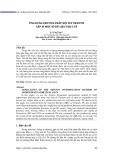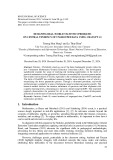
T
ẠP CHÍ KHOA HỌC
TRƯ
ỜNG ĐẠI HỌC SƯ PHẠM TP HỒ CHÍ MINH
Tập 22, Số 3 (2025): 401-413
HO CHI MINH CITY UNIVERSITY OF EDUCATION
JOURNAL OF SCIENCE
Vol. 22, No. 3 (2025): 401-413
ISSN:
2734-9918
Websit
e: https://journal.hcmue.edu.vn https://doi.org/10.54607/hcmue.js.22.3.4505(2025)
401
Research Article*
EXISTENCE OF NONTRIVIAL NONNEGATIVE WEAK SOLUTIONS
FOR A CLASS OF LOGISTIC-TYPE SYSTEMS
Nguyen Bich Huy, Bui The Quan*
Ho Chi Minh City University of Education, Vietnam
*Corresponding author: Bui The Quan – Email: quanbt@hcmue.edu.vn
Received: September 14, 2024; Revised: February 26, 2025; Accepted: March 04, 2025
ABSTRACT
We consider the following logistic system
11
22
(,,) (,) in ,
(,,) (,) in ,
0, 0 on .
p
p
u f xuv g xu
v f xvu g xv
uv
λ
λ
−∆ = − Ω
−∆ = − Ω
= = ∂Ω
Assuming that the nonlinearities
i
f
and
i
g
satisfy certain growth conditions. We use the fixed
point index theory and monotone minorants techniques to prove the existence of solutions for the
system. This extends some known results.
Keywords: fixed point index; logistic system; (p-1) – sublinear
1. Introduction
In this paper, we study the system
11
22
(,,) (,) ,
(,,) (,) ,
0,
p
p
u f xuv g xu in
v f xvu g xv in
u v on
λ
λ
−∆ = − Ω
−∆ = − Ω
= = ∂Ω
(1)
where
,uv
are non-trivial, non-negative unknown functions,
( 2)
N
N
Ω⊂ ≥
represents a
bounded domain with a smooth boundary
∂Ω
,
2
div(| | )
p
pu uu
−
∆= ∇ ∇
denotes the
p
-
Laplacian with
1pN<<
,
0
λ
>
is a real parameter, and
, , 1, 2
ii
fgi=
are appropriately
chosen functions.
Our objective is to identify a solution
(,)uv
that satisfies the condition of
,,,.uv u v
θθθ
≥≠≠
Cite this article as: Nguyen, B. H., & Bui, T. Q. (2025). Existence of nontrivial nonnegative weak solutions for
a class of logistic-type systems. Ho Chi Minh City University of Education Journal of Science, 22(3), 401-413.
https://doi.org/10.54607/hcmue.js.22.3.4505(2025)

HCMUE Journal of Science
Nguyen Bich Huy & Bui The Quan
402
Based on the growth rate of the functions concerning their second variable, we classify
the system of equations (1) into three categories:
( )
p1−
-sublinear,
( )
p1−
-linear, and
( )
p1−
- superlinear.
The system (1) extends the symbiotic model that describes the coexistence of two
species within the same habitat. Specific forms of this model have been studied (Delgado et
al., 2000; Yang & Wang, 2007). According to the aforementioned classification, Delgado et
al., (2000) and Yang and Wang (2007) focused on the
( )
p1−
-linear case. In a previous
work, we investigated problem (1) in the
( )
p1−
- sublinear case (Nguyen & Bui, 2017). In
this paper, we explore the
( )
p1−
-linear, and
( )
p1−
- superlinear growth cases for the
second variable in the functions
, 1, 2
i
fi
=
.
Our research approach aligns with earlier studies. First, we reduce problem (1) to a
fixed-point problem. Then, by determining the degree of the solution operator, we establish
the existence of solutions for the system.
2. Eigenfunction and eigenvalue
Proposition 2.1. Assume that
0
λ
is the principal eigenvalue of the problem
2
0
p
pu m( x )|u| u in ,
u on ,
λ
−
−∆ = Ω
= ∂Ω
(2)
and
00 0 0
( ), ,vC v v
θθ
∞
∈Ω≥ ≡
/
.
Then, the problem
20
( )| | in ,
0 on ,
p
pu mx u u v
u
λ
−
−∆ = + Ω
= ∂Ω
(3)
Has no non- negative solution
u
θ
≥
if
0.
λλ
>
Proof. By contradiction, we assume that
wK∈
is a solution to the problem (3). Since
0
λλ
>
and
0
v
θ
≥
then
w
is an upper solution of the following problem:
2
00
( )| | ,
0.
p
p
u m x u u v in
u on
λ
−
−∆ = + Ω
= ∂Ω
(4)
It is easy to see that
u
θ
=
is a lower solution of (4). Therefore, problem (4) has a
solution
u
(Drabek & Hernandez, 2001) satisfying
uw
θ
≤≤
. According to the theorem on
nonlinear regularity (Papageorgiou et al., 2009), we deduce that
1
0()uC∈Ω
. According to
Vázquez's strong maximum principle (Vázquez, 1984), we have
int( )uC
+
∈
. Let
0
u
be the
eigenfunction corresponding to the principal eigenvalue
0
λ
of the problem (2). Applying the
Díaz-Saa-Brezis inequality (Diáz et al., 1987), we obtain

HCMUE Journal of Science
Vol. 22, No. 3 (2025): 401-413
403
( ) ( )
0
11 11
000
1 11
0
()
() () 0.
()
pp
pp pp
p pp
u tu
vu tu u tu
u u tu
−− −−
− −−
−∆ −∆
−=− −≥
Letting
t
tend to infinity, we obtain
01p
v
u
θ
−=
, which contradicts the assumption about
0
v
.
3. A reduction to the fixed point equations
Let
N
Ω⊂
be a bounded domain with a smooth boundary
1pN<<
. We denote the
norms in the spaces
1,
0()
p
WΩ
and
()
t
LΩ
by
.‖‖
and
.t
‖‖
respectively. In these spaces, we
consider the order cone of nonnegative functions.
In this paper, we make the following assumptions on the functions
i
f
and
i
g
,
1, 2.i=
- (g1)
( ,0) 0
i
gx =
, and
(,)
i
g xu
is an increasing function with respect to
u
for almost
every
x∈Ω
.
- (g2) There exist constants
0
i
a>
,
*
01p
β
<< −
, and functions
( 1)
()
i
bL
β
′
+
∈Ω
such
that
| (,)| | | (), (,) .
i ii
g xu a u b x xu
β
≤ + ∀ ∈Ω×
- (f)
| ( , , )| ( )| | ( )| |
i ii
f xuv m x u n x v
αγ
+
, where
*
,1p
αγ
<−
and
(), ()
qr
ii
mL nL
∈Ω ∈Ω
with
**
( ), ( )
11
pp
qr
αγ
′′
>>
++
.
Then, Nguyen and Bui (2017) established that
1, 1,
00
(,) () ()
pp
uv W W∈ Ω× Ω
is a solution
to problem (1) if and only if
(,) (,)uv Po Nuv
λ
=
, where
12
12
:( , )
ff
PoN PoN PoN=
and
1,
0
( , )( ) ( , ( ), ( )), , ( ).
p
f
N uv x f xux vx uv W= ∀∈ Ω
4. The main results
Theorem 4.1. (The case (𝑝𝑝 − 1) – linear) Suppose that the Caratheodory functions
: ,: ,
ii
gf
++ +++
Ω× → Ω× × →
1, 2i=
satisfy the condition (g1) and
(H1) (a)
() (,) ()
ii i ii
az bx gxz ez bx
ββ
− ≤ ≤+
where
,0
ii
ae>
and
*
11pp
β
−< < −
,
'
( ,( ) ( ), 1) , 1, 2
;
s
i
N
b x L s max i
p
β
∈Ω= +
=
(b)
1
0
(,)
lim 0
ip
z
g xz
z
+
−
→
=
uniformly in
, 1, 2.iΩ=
(H2)(a)
11
0 (,,) () () , (,,)
pp
i ii
f xzt m xz n xt xzt
− − ++
≤ ≤ + ∀ ∈Ω× ×
where
''
*
( 1)
( ), , ( ), , 1,2.
( 1) 1
qr
ii
pp
mL q nL r i
p pp
β
β
+
∈Ω> ∈Ω> =
− ++
(b)
(,,) 0, (,,) ,(,) (0,0).
i
f xzt xzt zt
++
> ∀ ∈Ω× × ≠

HCMUE Journal of Science
Nguyen Bich Huy & Bui The Quan
404
(H3) There exist the functions
, , ()
s
iii
p p pL
θθ
≥ ≠ ∈Ω
where
N
sp
>
and the
constant numbers 𝑒𝑒𝑖𝑖 such that for every consequence satisfying
0 , ,
nn
zz
ξ
+
→→
n
tt→
then
11
1
(, , )
lim ( ) , 1, 2.
pp
i n n nn ii
p
nn
fx z t p x z et i
ξξ
ξ
−−
−
→∞
= +=
Let
, 1, 2
ii
λ
=
be the eigenvalues corresponding to the following problems:
2
( )| | in , 0 on .
p
pi
u px u u u
λ
−
−∆ = Ω = ∂Ω
Then, for every
12
max{ , }
λ λλ
>
, problem (1) has at least a solution
(,)
uv
such that
,,,.uv u v
θθθ
≥≠≠
Proof. We will still denote
12
(,) ( (,), (,))
ff
Nuv N uv N uv
λλ
=
and still split the proof into
three steps.
Step 1. We will show that there exists a sufficiently large positive number 𝑅𝑅 such that
( , ) [ ( , )], [0,1], , , ( , ) .uv PtNuv t uv uv R
θ
≠ ∀∈ ∀ ≥ =
Assume the contrary that there exist sequences
{ } [0,1]
n
t⊂
, and
, ,( , )
nn nn
uv uv
θ
→∞‖‖
such that
(,) [ (,)]
nn n nn
uv PtNuv
=
, or equivalently, one has
11
1,
0
22
, (, ) (, , )
, ( ).
, (, ) (, , )
n n n nn
p
n n n nn
Au g xu t f xu v
W
Av g xv t f xv u
ϕϕ ϕ
ϕφ
φφ φ
ΩΩ
ΩΩ
〈 〉+ =
∀∈ Ω
〈 〉+ =
∫∫
∫∫
(2)
Choosing
,
nn
uv
ϕφ
= =
in (7) and using
( 2)( )Ha
, we obtain
2
1
11
22
1
1(, ) () () ,
(, ) () () .
p
n nn n n n
p
n
pp
nn n n n
pp
u g xu u m xu n xv u
v g xv v m xv n xu v
Ω ΩΩ
ΩΩ
−
Ω
−
++
++
∫ ∫∫
∫ ∫∫
‖‖
‖‖
(3)
Adding sides by sides of the inequalities in (3), we have
1
1 21
11
2
. ( , ) () () () () .
n
pp pp
nn n n n n n
C u v m xu m xv n xv u n xu v
α
+
Ω ΩΩ Ω
−−
≤ ++ +
∫ ∫∫ ∫
‖‖
(4)
By Holder's inequality, Young's inequality, and some simple computations, we obtain
( )
1
12
1'
11
1 2 12
(,) (,) (,)
[ () () ] [ () () ]
pp
nn nn nn
q q pq
pp
nn nn n n
uv Cuv Cm m uv
n xv u n xu v b xu b xv
β
β
+
+
−−
ΩΩ
+ ≤+ +
+ + ++
∫∫
(5)
Applying the Hölder and Young’s inequalities, we get

HCMUE Journal of Science
Vol. 22, No. 3 (2025): 401-413
405
11 ''
1 2 12
[ () () ] ( , ) ()( , )
pt
pp rr
n n n n nn nn
rr p t
nxv u nxu v Cn n uv C uv
εε
−−
Ω
+ ≤+ +
∫
(6)
where
'
( 1) '
( 1) 1 .'''
p pr
tpr
rpr
p
β
−
= − = <+
−
From (5), (6), we have
1'
1'
(,) (,) (,) (,) 1.
t
pp
r
nn nn nn nn
pq t
uv uv C uv uv
β
β
+
+
+ ≤ ++
(7)
Since
'
( 1)
( 1) 1
p
rpp
β
β
+
>
− ++
then
1
t
β
<+
. Therefore, (6) follows
1
1'
(,) (,) (,) .
pp
nn nn nnpq
uv uv Cuv
β
β
+
+
+≤
(8)
If
'1pq
β
≤+
then
1
11
(,) (,) (,) .
pp
nn nn nn
uv uv Cuv
β
ββ
+
++
+≤
(9)
From (9) we get
1
(,)
nn
uv
β
+
→∞
. This contradicts
1.p
β
<+
If
1pq
β
′>+
, it follows from the hypothesis
( )
4H
, we obtain
*
.pq p
′<
Applying the
interpolation inequality, we obtain
()
()
( )( )
( ) ()
( ) ()
**
**
*
*
11
11
1 11
11
1
1
1
1
, ..
.
, .,
, .,
nn n n n n n n
pq pq p p
pq
n n nn
pp
nn nn
p
nn nn
p
uv u v Cu u v v
Cu v u v
Cuv uv
Cuv uv
θ θθ θ
ββ
θ θ θθ
ββ
θθ
β
θθ
β
−−
′′ ++
′
− −−
++
−
+
−
+
=+≤ +
≤+
≤
≤
(10)
where
( )
0;1
θ
∈
is defined by
*
11 11
.
11pq p
θ
ββ
−= −
′
++
It follows from (9), we get
( ) ( )
, .,
nn nnpq
uv C uv
′
≤
and
( ) ( )
1
1
, ,,
p
nn nnpq
uv uv
β
β
+
′
+
≤
Combined with (10), we obtain
(1 ) 1
.
p
nn
pq pq
u Cu
θθ
β
+− +
′′
≤
Note that
1p
β
<+
then
(1 ) 1
1p
θθ
β
+− <
+
. Therefore, in the above inequality, we have a
contradiction with
( )
,.
nnpq
uv ′→∞


























